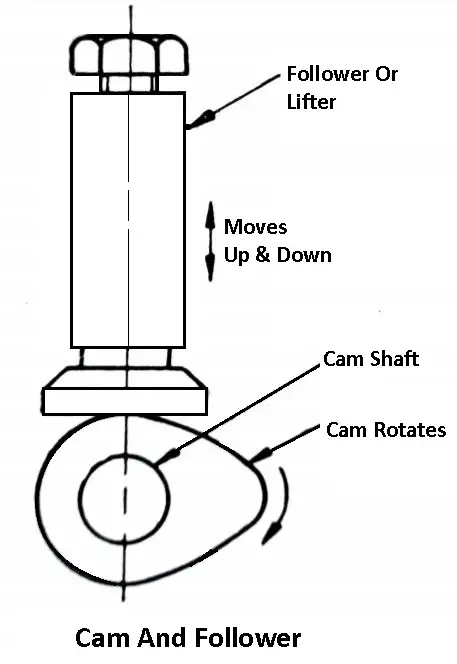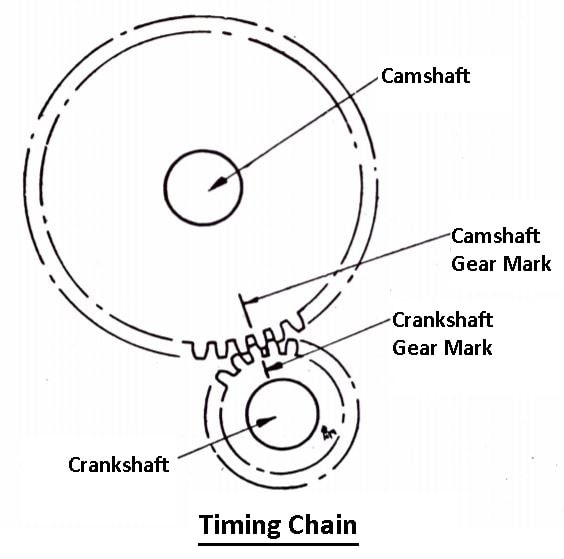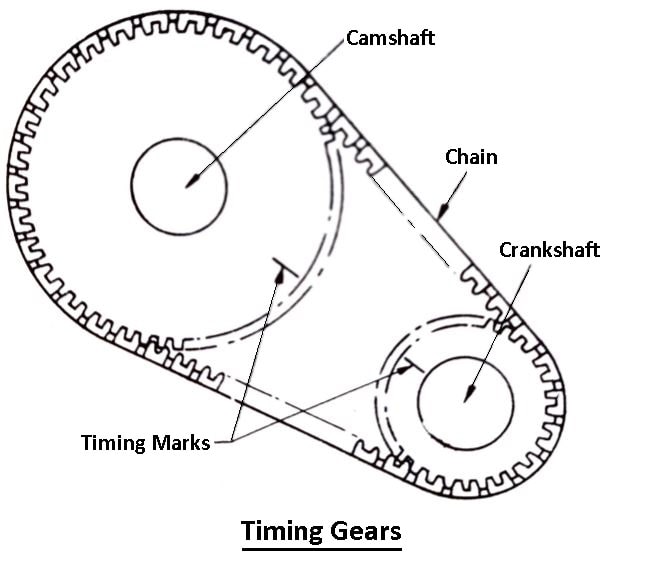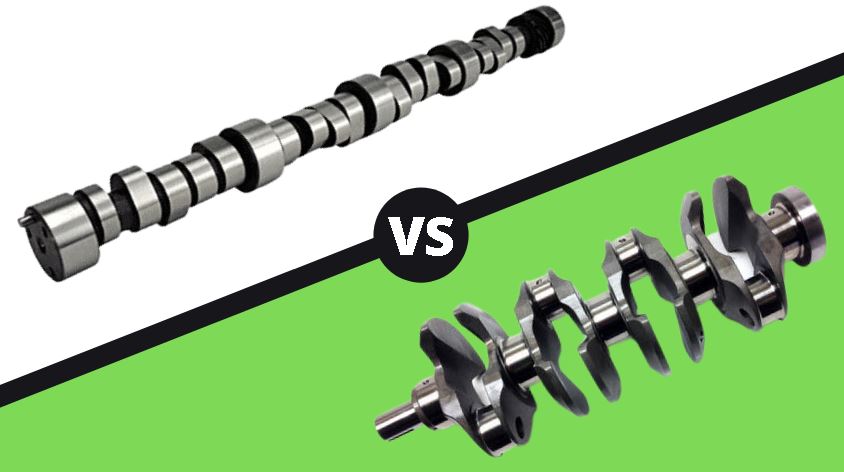In this article, you’ll learn what is camshaft its parts and function. How does it work? Explained in detail with definition, working, materials, and application of camshaft. Also, you can download the PDF file at the end of this article.
What is Camshaft?
A camshaft is only a shaft on which cams are installed. The camshaft is mounted on bearing in the lower part of the cylinder block, most in-line engines. In some engines, it is placed on the cylinder head.
A cam is a device that changes the rotary motion of the camshaft into linear motion of the follower or filter. The cams have a high spot or lobe. The follower riding on the cams will move away from or towards the camshaft as the cam rotates.

A camshaft is responsible for opening the valves. A camshaft has several cams along with the length, two cams for each cylinder, one to move the inlet valve and the other to operate the exhaust valve.
Furthermore, the camshaft has an eccentric to run the fuel pump and gear to operate the ignition distributor and oil pump.
Parts of Camshaft
Following are the main parts of camshaft assembly:
- Cam bearing journals
- Bearing Shells
- Lobes
- Thrust plate
- Chain sprocket
- Woodruff key

1. Cam Bearing Journals
The cam is a rotating component that provides reciprocating or oscillating motion to the follower by direct contact. This is typically used to change the movement from the rotary to linear.
2. Bearing Shell
The bearing shell is part that is mounted on the cam bearing journals. It helps to protect the camshaft from breaking the engine block in case of engine failure. Bearing shells keep the camshaft in a smooth rotation.
3. Lobes
During the rotation of the camshaft, the lobes work with the motion of the piston. The purpose of lobes is to open and close the valves for intake and exhaust gases. Its speed usually depends on the engine speed.
4. Thrust Plate
When using a roller cam you will need to provide some means to support the cam at the rear of the engine. The thrust plate is attached between the cam and timing gear and mounted on the front cover for proper end play.
5. Chain Sprocket
A chain sprocket is attached to the camshaft end of the engine to retain the timing belt. This sprocket is attached to a chain. These sprockets are capable of turning at the same speed even if they do not touch.
6. Woodruff Key
The woodruff key is also the main part of the camshaft of the engine that is used to retain the cams at the right time.
How does Camshaft work?
The camshaft is operated by the crankshaft either by a pair of meshing gears (timing gears) or a pair of timing sprockets connected by chains. The camshaft gear or sprocket has as many teeth as the gear or sprocket on the crankshaft.

This gives a 1:2 gear ratio. The camshaft rotates at half the speed of the crankshaft. Therefore every two revolutions of the crankshaft create one revolution of the camshaft and one opening and closing of each valve in the four-cylinder engine.
The gear and sprocket maintain a definite time relationship between the camshaft and crankshaft to insure opening the valves exactly at the correct time in relation to piston position.

Timing marks on the gears and sprockets are used to set the shaft incorrect times with each other when the units are assembled.
The figure shows that the smaller circle on the crankshaft timing gear must fall between the two smaller circles on the crankshaft timing gear to ensure correct valve timing. The sprocket marks are in a straight line with the centers of both shafts to ensure correct valve timing.
Material used for Camshaft
An engine camshaft is made of solid metal to achieve greater rigidity. Camshafts are usually made of cast iron as it gives more strength and is also used for mass production.
A chilled iron camshaft can give you good wear resistance and hence the chilling process hardens the material. A variety of materials are mixed with iron to form more suitable properties for the purpose of its application.
Some manufacturers also use billet metal when high quality and low production is required. However, it requires more time and cost than other methods. It is manufactured by forging, casting, or machining on a lathe and milling machine.
Causes of a Failure Camshaft
There are many problems that can be created on the camshaft. If you neglect these problems, it can cause you a heavy loss and complete breakdown of the engine.
Following are the causes of the damaged camshaft:
- Due to the wear of the lobe.
- Due to the improper brake-in.
- Because of the damaged cam of a camshaft.
- Using oil filters with a new cam.
- Due to mechanical interference occurrences such as spring coil bind, retainer to seal, valve to piston interference, and rocker arm slot to stud.
- Because of the large end play provided on the camshaft.
- Due to the usage of cheap dowel pins or Woodruff keys.
- Because of the incorrect pressure of the valve spring.
Camshaft and Crankshaft: What’s the Difference?

Following are the main points of difference between camshaft and crankshaft:
| Camshaft | Crankshaft |
|---|---|
| As the engines work they need to breathe out exhaust gases and take in fresh air for the next cycle to take place. | This part of an engine is a shaft as the name suggests on which all the units of an engine are mounted. |
| A camshaft is generally made of cast iron or steel by casting process or machining on lathe or milling machine. | A crankshaft is typically made of alloy steel by the forging process. |
| The camshaft is located at the top of the cylinder head. | The crankshaft is located at the bottom of the cylinder head. |
| A camshaft is used to open or close the engine valve for the right timing. | A crankshaft is employed to convert the reciprocating or oscillating motion of the piston into rotary motion. |
| The camshaft is rotated by the timing belt and is attached to the crankshaft. | The crankshaft is rotated with the help of a piston. |
Applications of Camshaft
The camshaft is the rotating part of the engine cylinder. They are mainly employed to convert rotary motion into reciprocating motion.
In the I.C engine, the camshaft is employed to operate the intake and exhaust gas from the poppet valve, which is mechanically controlled by the ignition system and electric motor.
Sometimes the camshaft also operates as rocker arms to move the exhaust valve from the back of the cam that is 180 degrees with the inlet valve.
Conclusion
So now, I hope I’ve covered everything about the camshaft its parts, and function. If you still have any doubts or questions on this topic, you can contact us or ask in the comments.
If you like this article then please share it with your friends. Subscribe to our newsletter to get notified when we upload new posts. It’s Free.
And finally download the PDF file of this article by clicking here.
You may like to read more in our blog:
- List of Car Engine Parts: Its Function and Uses (With Pictures)
- Why Does Knocking Occur In An Engine and Its Remedies
- Spark Plug: Types, Parts and Working Principle (PDF)
FAQ
A camshaft is a rod that rotates and slides in an engine to convert rotational motion into linear motion. This speed is achieved by moving the camshaft further and closer to the axis of rotation as the camshaft is driven by the engine.
The camshaft is vital to the basic function of the engine. Made of two separate parts, the cam and shaft, the camshaft is meant to enable the valve to open. As the shaft turns, the cams push the valves open in sync with the crankshaft gears.
A camshaft is an egg-shaped cam that allows air to enter the cylinder by opening and closing the engine’s valves. The crankshaft is a shaft used to convert the reciprocating or oscillating motion of a piston into a rotary motion.
In the internal combustion engine, the camshaft is used to move the intake and exhaust gas from the poppet valve, which is managed by the ignition system and electric motor.
I need a pdf
The PDF file has been sent to your inbox.
I’m in need of a PDF sir
The PDF file has been sent to your inbox.
Hello sir I need a pdf
The PDF file has been sent to your inbox.
Dear Sir or madam
Could you please advise me on fitting a diesel camshaft into a petrol engine,and vice versa a petrol camshaft in a diesel engine.
The camshafts both do the same job but with slight differences, as the diesel engine runs more like a 2stroke engine, would changing the drive chain sprokets balance this out . Thank you for your time in advance for answering this question.
Wayne.
It’s not recommended to fit a diesel camshaft into a petrol engine or vice versa, and changing the drive chain sprockets won’t balance out the differences. It’s best to use the appropriate camshaft designed for your specific engine type.
Good concept
Thanks for reading.
I need a PDF sir
The PDF file has been sent to your inbox.
I need the PDF sir
The PDF file has been sent to your inbox.
Sir I need the PDF pls
The PDF file has been sent to your inbox.
Sir please kindly send me Pdf
The PDF file has been sent to your inbox.
I have understood a camshaft and it’s function parts and disorders
I’m glad it was helpful for you.